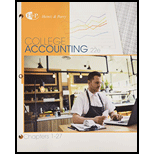
Bundle: College Accounting, Chapters 1-27, Loose-Leaf Version, 22nd + CengageNOWv2, 2 terms Printed Access Card
22nd Edition
ISBN: 9781305930421
Author: James A. Heintz, Robert W. Parry
Publisher: Cengage Learning
expand_more
expand_more
format_list_bulleted
Question
Chapter 24, Problem 7SEB
(a)
To determine
Compute price-earnings ratio.
(b)
To determine
Calculate book value per share of common stock.
Expert Solution & Answer
Trending nowThis is a popular solution!

Students have asked these similar questions
General Accounting
Determine the adjusted bank balance
Solve this Accounting problem
Chapter 24 Solutions
Bundle: College Accounting, Chapters 1-27, Loose-Leaf Version, 22nd + CengageNOWv2, 2 terms Printed Access Card
Ch. 24 - A comparison of amounts for the same item in the...Ch. 24 - Prob. 2TFCh. 24 - Prob. 3TFCh. 24 - Prob. 4TFCh. 24 - Prob. 5TFCh. 24 - Prob. 1MCCh. 24 - Prob. 2MCCh. 24 - Working capital is a measure of (a) liquidity. (b)...Ch. 24 - Prob. 4MCCh. 24 - Prob. 5MC
Ch. 24 - Prob. 1CECh. 24 - Prob. 2CECh. 24 - Compute the following profitability measures for...Ch. 24 - Prob. 4CECh. 24 - Prob. 5CECh. 24 - Prob. 6CECh. 24 - Prob. 1RQCh. 24 - Prob. 2RQCh. 24 - Prob. 3RQCh. 24 - Prob. 4RQCh. 24 - Prob. 5RQCh. 24 - Prob. 6RQCh. 24 - Prob. 7RQCh. 24 - Prob. 8RQCh. 24 - Prob. 9RQCh. 24 - Prob. 10RQCh. 24 - Prob. 11RQCh. 24 - Prob. 12RQCh. 24 - Prob. 13RQCh. 24 - Prob. 1SEACh. 24 - Prob. 2SEACh. 24 - ANALY SIS OF PROFITABILITY Based on the financial...Ch. 24 - ANALY SIS OF LEVERAGE Based on the financial...Ch. 24 - Prob. 5SEACh. 24 - Prob. 6SEACh. 24 - Prob. 7SEACh. 24 - Prob. 8SPACh. 24 - Prob. 9SPACh. 24 - RATIO ANALYSIS OF COMPARATIVE FINANCIAL STATEMENTS...Ch. 24 - Prob. 1SEBCh. 24 - ANALYSIS OF ACTIVITY MEASURES Based on the...Ch. 24 - Prob. 3SEBCh. 24 - Prob. 4SEBCh. 24 - Prob. 5SEBCh. 24 - Prob. 6SEBCh. 24 - Prob. 7SEBCh. 24 - Prob. 8SPBCh. 24 - Prob. 9SPBCh. 24 - RATIO ANALYSIS OF COMPARATIVE FINANCIAL STATEMENTS...Ch. 24 - Prob. 1MPCh. 24 - This problem challenges you to apply your...
Knowledge Booster
Learn more about
Need a deep-dive on the concept behind this application? Look no further. Learn more about this topic, accounting and related others by exploring similar questions and additional content below.Similar questions
- The Stellar Supplies Inc. estimates the factory overhead for the upcoming year will be $1,440,000. The company has decided to use labor hours as the basis for applying overhead, which is estimated to be 48,000 hours. Calculate the predetermined overhead rate to apply factory overhead.arrow_forwardPlease right solution and accounting questionarrow_forwardStep by step answerarrow_forward
- Clarity National Bank's financial records include a beginning cash balance of $142,500. During the period, deposits totaling $18,300 were outstanding, while checks amounting to $14,900 were still unpaid. Additionally, the bank applied a service charge of $210. Determine the adjusted bank balance based on these figures.arrow_forwardRonan Mart recorded the following: cash sales $47,500, credit sales $69,000, sales return $5,200, sales allowances $3,700, and early payment discount taken by customers $2,900. Calculate the net sales. a) $104,700 b) $105,600 c) $106,700 d) $107,500arrow_forwardProvide answerarrow_forward
- Boston Acoustics is a start-up company that manufactures high quality sound amplifiers.arrow_forwardGeneral accounting questionarrow_forwardBrightstar Financial Services recorded several financial transactions during the period. The company received $38,500 in cash from credit customers and allowed $3,200 in sales discounts. Additionally, $2,100 in bad debts were written off. Given that the beginning balance of Accounts Receivable was $92,000, calculate the ending balance of Accounts Receivable.arrow_forward
arrow_back_ios
SEE MORE QUESTIONS
arrow_forward_ios
Recommended textbooks for you
 College Accounting, Chapters 1-27AccountingISBN:9781337794756Author:HEINTZ, James A.Publisher:Cengage Learning,
College Accounting, Chapters 1-27AccountingISBN:9781337794756Author:HEINTZ, James A.Publisher:Cengage Learning, Cornerstones of Financial AccountingAccountingISBN:9781337690881Author:Jay Rich, Jeff JonesPublisher:Cengage Learning
Cornerstones of Financial AccountingAccountingISBN:9781337690881Author:Jay Rich, Jeff JonesPublisher:Cengage Learning Managerial AccountingAccountingISBN:9781337912020Author:Carl Warren, Ph.d. Cma William B. TaylerPublisher:South-Western College Pub
Managerial AccountingAccountingISBN:9781337912020Author:Carl Warren, Ph.d. Cma William B. TaylerPublisher:South-Western College Pub Managerial Accounting: The Cornerstone of Busines...AccountingISBN:9781337115773Author:Maryanne M. Mowen, Don R. Hansen, Dan L. HeitgerPublisher:Cengage Learning
Managerial Accounting: The Cornerstone of Busines...AccountingISBN:9781337115773Author:Maryanne M. Mowen, Don R. Hansen, Dan L. HeitgerPublisher:Cengage Learning Financial And Managerial AccountingAccountingISBN:9781337902663Author:WARREN, Carl S.Publisher:Cengage Learning,
Financial And Managerial AccountingAccountingISBN:9781337902663Author:WARREN, Carl S.Publisher:Cengage Learning, College Accounting, Chapters 1-27 (New in Account...AccountingISBN:9781305666160Author:James A. Heintz, Robert W. ParryPublisher:Cengage Learning
College Accounting, Chapters 1-27 (New in Account...AccountingISBN:9781305666160Author:James A. Heintz, Robert W. ParryPublisher:Cengage Learning

College Accounting, Chapters 1-27
Accounting
ISBN:9781337794756
Author:HEINTZ, James A.
Publisher:Cengage Learning,

Cornerstones of Financial Accounting
Accounting
ISBN:9781337690881
Author:Jay Rich, Jeff Jones
Publisher:Cengage Learning

Managerial Accounting
Accounting
ISBN:9781337912020
Author:Carl Warren, Ph.d. Cma William B. Tayler
Publisher:South-Western College Pub

Managerial Accounting: The Cornerstone of Busines...
Accounting
ISBN:9781337115773
Author:Maryanne M. Mowen, Don R. Hansen, Dan L. Heitger
Publisher:Cengage Learning

Financial And Managerial Accounting
Accounting
ISBN:9781337902663
Author:WARREN, Carl S.
Publisher:Cengage Learning,

College Accounting, Chapters 1-27 (New in Account...
Accounting
ISBN:9781305666160
Author:James A. Heintz, Robert W. Parry
Publisher:Cengage Learning
Dividend explained; Author: The Finance Storyteller;https://www.youtube.com/watch?v=Wy7R-Gqfb6c;License: Standard Youtube License